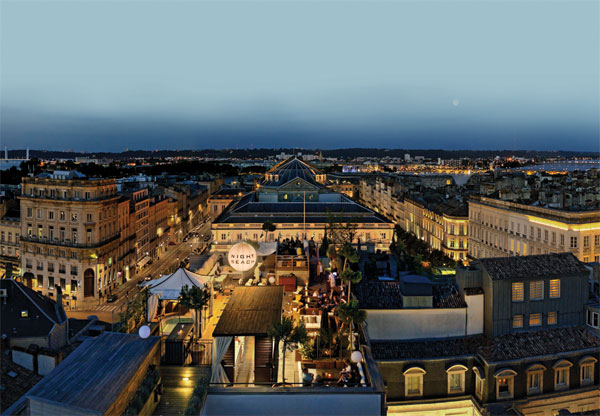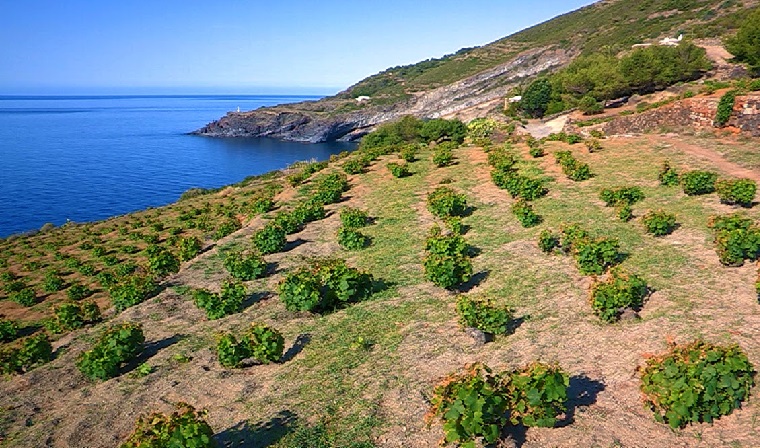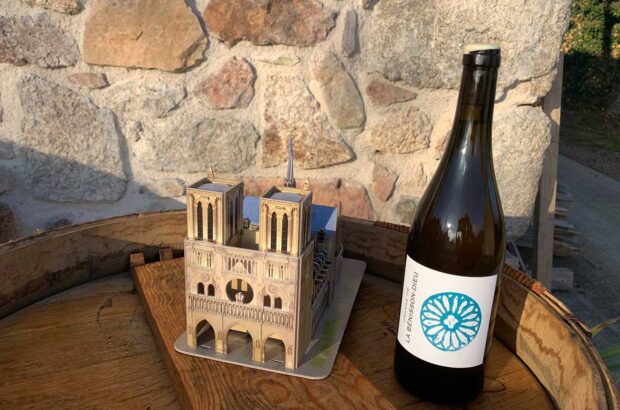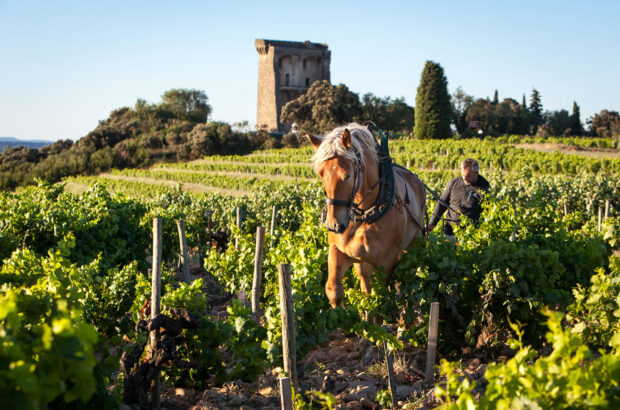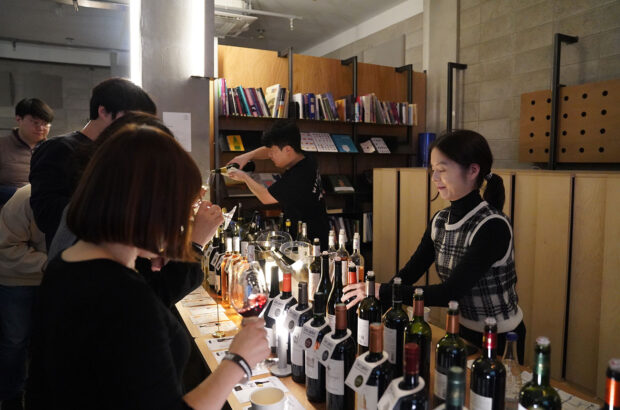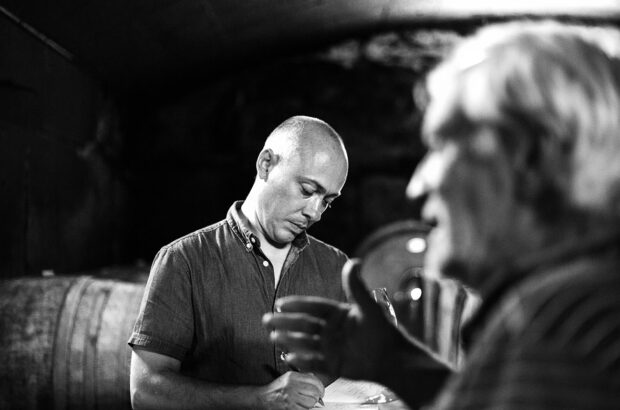Updated July 2019.
Champagne
Getting there: One hour drive from Paris or 40 minutes on TGV train from Paris Gare du Nord.

Riddling racks in the Krug cellars in Champagne. Credit: Krug.
Champagne came oddly late to the UNESCO World Heritage list; its vineyards, houses and miles of underground cellars making the exclusive club in 2015.
It has arguably also been a little slow to consider the potential of wine tourism, given that it lies barely an hour from Paris, one of the most visited cities in the world.
But, things are changing in this part of the world and several houses are well worth a visit.
Decanter contributor and Tyson Stelzer recently shared his tips on where to go in Champagne.
At the November Decanter Fine Wine Encounter in London, we asked several Champagne producers and representatives for their favourite local restaurants. Words: Chris Mercer.
See also: Ten tips for visiting Champagne houses
The Azores
Getting there: International flights land at the largest island, São Miguel, for connecting ones to the smaller islands. You can fly to some islands from Lisbon also.

The port of Velas on the Island of Sao Jorge, the Azores.
The Azores have two UNESCO sites; one being the Pico Island vineyard culture. The second largest of the islands, Pico’s vinicultural history dates back to the 15th century, with a series of spaced out linear walls across the island that protect small plots of land from wind and seawater. Sarah Ahmed recommends where to stay and eat on Pico, and more of the islands.
On the island of Terceira, the 15th century port is also a UNESCO site, listed as a ‘unique example of military architecture’. Words: Ellie Douglas
See also: Wine lover’s guide to Ponta Delgada
Prosecco, Italy
Getting there: Fly into Venice, then it’s less than an hour to the hills of Prosecco.

The dramatic landscape of Prosecco’s Conegliano Valdobbiadene territory
One of the latest additions to the UNESCO World Heritage sites, the landscape of Le Colline del Prosecco di Conegliano e Valdobbiadene was added in July 2019.
The vinegrowing area for Prosecco DOCG is included as part of this, in particular the ‘ciglioni’ – small plots of vines on narrow grassy terraces – and the ‘bellussera’ method of training vines, as examples of man’s influence on shaping and adapting this natural landscape.
Take a tour of the Prosecco vineyards to see it for yourself.
It’s also easy to combine this trip with other nearby UNESCO sites – such as Venice and its lagoon, or the city of Verona. Words: Ellie Douglas
See also: Best restaurants in Venice for wine lovers
Tokaj, Hungary
Getting there: Fly to Budapest, then it’s a three-hour drive to Tarcal via the M3 motorway. A direct train from Budapest Keleti station to Tokaj takes 2.5 hours.

Tokaj vineyards of Oremus Estate. Credit: Hans-Peter Siffert / Bon Appetit / Alamy
Hungary’s Tokaj appellation, characterised by its rolling and verdant hills, has the distinction of being Europe’s first classified wine region. The thousand-year-old winemaking traditions that still remain in place today make it an obvious choice for UNESCO world heritage designation.
Home to the famous Tokaji-Aszú dessert wine (characterised by French King Louis XIV as ‘the wine of kings, the king of wines’), it is also noteworthy for its labyrinthine cellars where these historic sweet wines are stored.
The Ungvári cellar in Sátoraljaújhely, near the Slovakian border, comprises four floors which connect 27 different cellars, accessed from different, above-ground gates. Covered in extraordinary mould, the cellar labyrinth is one ingredient that contributes to the magic of these dessert wines. Words: Katie Kelly Bell
Loire Valley, France
Getting there: Fly to Paris-Orly and Sancerre is a two-hour drive. Alternatively, take a train from Paris to Tours. Saumur is then a one-hour drive west. Sancerre is a two-and-a-half-hour drive east from Tours. You can also fly to Tours.
With its swathes of rolling vineyards and wheat fields surrounding palaces built or modified during the Renaissance, the Loire is a vivid testament to mankind’s golden age.
The UNESCO area of the Loire comprises 164 towns and villages – including Chinon, Samur and Angers – between the two hillsides that border the river from Sully-sur-Loire (Loiret) and Chalonnessur- Loire (Maine-et-Loire).
Many of the region’s charming villages and roadways are vestiges of the enormous Roman influence, as the Loire was a vital waterway between Rome and ancient Gaul. Words: Katie Kelly Bell
Valparaíso, Chile
Getting there: Valparaíso is about a one hour drive from the capital city of Santiago.

The view over Valparaíso
The historic quarter of the Port city of Valparaíso has been a UNESCO site since 2003, due to its ‘industrial-age heritage associated with the international sea trade of the late 19th and early 20th centuries.’
As a destination for wine lovers, it’s close to both the winemaking regions of Casablanca and San Antionio Valley, as well as home to great restaurants for those who love wine and fresh seafood.
Explore the hilly streets of this city, and be sure to take the self-guided wine street art tour. Words: Ellie Douglas
Ten of the best restaurants in Santiago, Chile
Douro Valley, Portugal
Getting there: Fly to Porto. One-hour drive to the heart of the valley, or a more scenic route is the 2.5 hour train ride, known as the Linha do Douro.

An opulent manor in the homeland of Port… Image Credit: sixsenses.com
Demarcated in 1756, the Douro is one of the world’s oldest wine regions and is a UNESCO World Heritage Site because of the human influence on its development. More than 2,000 years of winemaking have shaped it into a terraced, vine-covered, wine-producing destination.
The highly acidic terroir is unforgiving schist, which winemakers have physically cracked and crushed to accommodate vines. Steep mountain contours require heavy terracing and water management; some vines have roots that run to 20m deep. Growing grapes here requires rare fortitude. Words: Katie Kelly Bell
See also:
Piedmont, Italy
Getting there: Fly to Turin. It’s then around 1hr 20 minutes in a car to Alba.

Autumnal sunrise in heartlands of Barolo in Piedmont’s Cuneo province. Federica Violin / Alamy.
The World Heritage Committee added the ‘vineyard landscape of Piedmont: Langhe-Roero and Monferrato’ in 2014.
The listing includes the towns of Barolo, Castiglione Falletto Grinzane Cavour, La Morra, Monforte d’Alba, Novello and Serralunga d’Alba in the Barolo DOCG, as well as Barbaresco and Neive in the Barbaresco DOCG.
In its submission for Piedmont, Italy’s government said, ‘Vine pollen has been found in the area dating from the 5th Century BC’. See how Decanter.com reported the story.
See also: Decanter travel guide to Piedmont
Middle Rhine, Germany
Getting there: Fly to Frankfurt or Cologne-Bonn airports and then it’s around 1hr 30 minutes in the car from each.
The Middle Rhine’s beauty is well-chronicled, but it gained UNESCO status for its role as a major trade artery in the evolution of history and human development.
Numerous hiking trails surround the villages, offering visitors magnificent vistas of vineyards and forested countryside. Riesling flourishes on the region’s precipitous hillsides but requires great care and skill during harvest (some slopes angle nearly 45˚).
The ideal way to explore the region, and certainly the most bucolic, is by boat. Consider making the village of Boppard your home base, a 2,000-year-old town that hosts an annual walk through the vineyards on the last Sunday in April. Words: Katie Kelly Bell
Bordeaux and St-Emilion, France
Getting there: Fly to Bordeaux Mérignac airport.
Bordeaux hardly needs introduction to wine lovers. According to UNESCO, the city’s 2,000-year-old role as the capital of a world-famous wineproducing region make it a shining example of cultural heritage. And in many ways, the city is as lovely and intriguing as the region’s châteaux.
In the past decade most of the buildings (previously covered in layers of grime and soot) have undergone a massive façade-cleansing, lending added lustre to the city’s grand structures. Words: Katie Kelly Bell
See also:
-
Château accommodation in Bordeaux – Living the dream
-
How to visit Bordeaux’s Cité du Vin wine theme park
Vienna, Austria
Getting there: Direct flights to Vienna go from both London and New York.

The city of Vienna offers plenty for wine lovers. Credit: Unsplash / Jacek Dylag
The historic city of Vienna originated from early Celtic and Roman settlements. It retained its importance as a Medieval and Baroque city, and was the capital of the Austro-Hungarian Empire, which is why the city was awarded UNESCO status in 2001 – although in 2017 it was added to the list of World Heritage in Danger sites.
Housing plenty of contemporary art, opera, theatre, coffee, sweet pastries and, of course, great food and local wine, it makes a great city break. Local resident Jason Turner recommends enjoying the ‘breathtaking’ view of Vienna than from the south-facing Nussberg vineyard in his Vienna city guide,
Wine lovers can also visit Austria’s winemaking region of Wachau, which is only an hour from the city. Words: Ellie Douglas
See also: Decanter travel guide: Wachau, Austria
Pantelleria, Italy
Getting there: Catch a ferry from Trapani in Sicily, which takes between six and eight hours. Alitalia operates flights from Trapani and Palermo – and also Milan and Rome in the summer months. A flight from Trapani takes about 40 minutes.
Looking for somewhere more remote to explore or get away from it all? The wild card entry in this selection is Pantelleria, 85km off Italy’s southern coast.
Its terraced bush vine growing technique handed down through centuries of generations was placed on the UNESCO world heritage list in late 2014.
Passito di Pantelleria, a sweet wine made from dried ‘Zibibbo‘ grapes, also known as Muscat of Alexandria, has DOC status in Italy. Moscato di Pantelleria is also a DOC.
Monticello, Virginia, USA

Monticello, home of Thomas Jefferson. Credit: Wikipedia (Creative Commons)
Monticello, the plantation home designed and inhabitated by Thomas Jefferson made the UNESCO world heritage list in 1987, along with the Unversity of Virginia in Charlottesville, where it is located.
Jefferson was notoriously a fan of wine and planted vineyards on the estate when he lived there – to varying degrees of success, according to reports of the time.
So, why not take in a piece of US history and also use the opportunity to find out how Virginia’s current generation of winemakers and vineyard owners are getting along?
Read Jill Barth’s round-up of exciting Virginia wines to look for and also see Andrew Jefford’s 2015 column on the region. Words: Chris Mercer
About UNESCO
The United Nations Educational, Scientific and Cultural Organisation (UNESCO) identifies cultural and natural examples of heritage around the globe with the goal of protecting and preserving them for future generations.
The organisation was founded in November 1945, just after the end of World War II, as a way to nurture humanity and heritage by developing ‘the intellectual and moral solidarity of mankind’.
Sites that qualify must have ‘outstanding value to humanity’. Once a site has been accepted, UNESCO offers everything from technical assistance and public awareness to professional training and emergency assistance to preserve sites.
UNESCO has 195 member states, while its World Heritage Committee, which meets yearly to select new sites and allocate funds as needed, has 21 member nations.
This year marks the 40th anniversary of the UNESCO World Heritage Convention, a treaty that has become the foremost international legal tool in support of the conservation of the world’s cultural and natural heritage. Words: Katie Kelly Bell
For more information, visit www.unesco.org.





